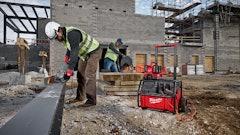
Break-even point is a concept that works very well in a manufacturing setting. It's the point at which you've covered all of your costs to produce a product; you are neither losing nor making money.
This concept can also work in landscape contracting. You determine how much work you'll have to produce in order to generate enough money to not only cover your direct costs of labor, materials, sub-contractors and equipment, but also your overhead.
Many contractors want to know when they'll break even for the year. This is especially important in areas of the country where landscapers experience a slowdown during the final two or three months of the year. They work hard to recover all of their annual overhead by this point of slowdown.
Contractors can also look at break-even points on a monthly basis, or even on a per-job basis. This type of scrutiny can help you avoid taking on too many low-profit or completely unprofitable jobs.
How break-even guides decisions
Frank Ross is a financial management expert specializing in the Green Industry. He says it's important for contractors to understand how to calculate a break-even point. This comes from knowing your numbers. But then it's even more important to understand how your break-even point will be impacted by some of the decisions you make.
For example, if you're thinking of buying a new $50,000 piece of equipment, how much additional revenue will you need to generate in order to pay for it? Or, if you're thinking of hiring an office manager, how much additional business will you need to generate in order to pay for that extra employee.
Here's an example that's fresh on a lot of contractors' minds. Let's say you're still in a really tough market. You might need to lower your prices by 10% in order to stay competitive. What does this do to your break-even point for the year?
If you've been doing $500,000 in annual sales with a 15% net profit, a 10% price reduction puts you at $450,000 in sales. But your direct costs and overhead will likely stay the same because you're performing the same work, just at a reduced price. So your break-even is still around $425,000 (85% of $500,000). You need to understand that your profit is going to be strained as a result of the price reduction ($450,000 in sales minus $425,000 in direct costs and overhead = $25,000 in profit as compared to the $75,000 in profit you used to enjoy).
If you want to make the same amount of profit for the year, you're going to have to sell more profitable work and/or cut costs in order to make up that $50,000 difference. This type of information is definitely good to know, which is why discovery of your break-even points and the subsequent break-even analyses are so valuable to a contractor.
If you're like 90% of landscape contractors, you could use some assistance with financial matters such as break-even analysis. Frank Ross can help. Check out his new training program: A Better Way 2 Learn Financials. You can download the first two lessons for free!



























